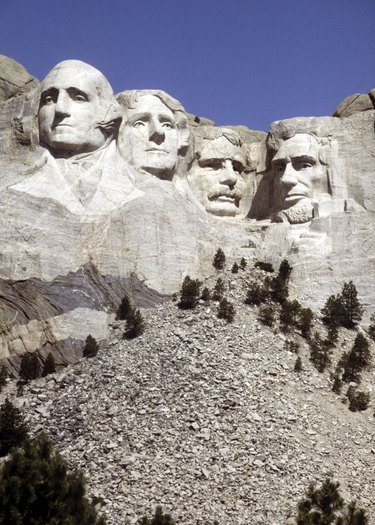
Obsidian and granite are igneous rocks, so-called because they were formed from the molten magma of volcanoes. Beyond that, their similarities end. Obsidian is not a genuine mineral or "rock." It is a natural glass that contains microscopic mineral crystals. Granite, the most common rock on the continental crust, is composed of visible crystals of feldspar, mica, quartz and other minerals.
Obsidian
Video of the Day

Obsidian contains 70 percent or more of silicon dioxide. It sometimes is classified as a mineraloid, meaning that it does not have the identifying crystal structure of a true mineral. Mineraloids may be liquid or solid. Mercury at normal temperatures is a mineraloid and so are pearls. Obsidian usually is black, although it can be brown or green. Black and brown sometimes join in swirls of color. Trace elements can result in blue, orange, red or yellow obsidian, and the surface sometimes can have a metallic sheen. Obsidian is chemically unstable, so white or gray crystals occasionally form on the interior. As a form of glass, obsidian shatters into pieces with sharp edges.
Video of the Day
Granite
On the surface, granite is exposed most often as the core of mountains. Stone Mountain, Georgia; Pikes Peak and the sides of Yosemite Valley in California are composed of granite. The crystals in granite are large enough to be seen with the naked eye and give granite its distinctive rough surface. Feldspar accounts for 10 to 50 percent of these minerals. Granite can range from pink to gray depending on the minerals it contains. Pink granite contains at least 20 percent quartz. Granite is dense, strong and tough, making it useful for construction.
Origins
Volcanoes erupt some obsidian as slow moving liquid, but the highest quality obsidian forms in vents just below the surface, so it is not contaminated by ash and dirt. Obsidian cools in hours or days. Granite cools miles underground over thousands to millions of years. This slow cooling allows the identifying crystals to form.
Uses
Obsidian breaks into curved fragments that have sharp edges. Archiac peoples used fractured obsidian as cutting tools and to make scrapers, knives and arrowheads. Obsidian is used as the cutting edge of some modern surgical instruments, and it sometimes is made into jewelry. Granite can bear heavy loads, resists scratching and weathering, and can be polished to a brilliant shine. The properties of granite make it useful for tombstones, buildings, bridges, stair treads, counter tops, floor tiles and monumental sculpture. The pyramids at Giza in Egypt are made of granite. The American presidents on Mt. Rushmore also are carved in granite.
- Oregon State University: Obsidian is Hot Stuff
- NJminerals: Granite
- James Madison University: An Introduction to Igneous Rocks
- Geology: Obsidian
- Geology: Granite
- Galleries: The Mineraloids Class
- The Energy Library: Mineraloid
- Rockhounds; The Rock Identification Key; Don Peck
- Math/Science Nucleus: Rock Cycle